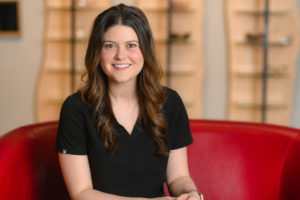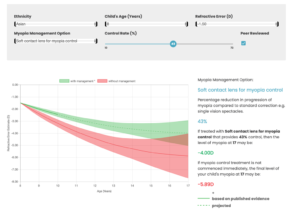March 1, 2023
By Kate A. McClure, OD, MS, FAAO
Parents who are skeptical of myopia management therapies often lack understanding and proper education. Parental skepticism can easily be curbed but only when proper education and information are provided.
 Skepticism from parents often comes from a misunderstanding of the expectations of myopia management or a lack of education about the treatment options and their intended outcomes. Before initiating any myopia management therapy, setting expectations is key. The most crucial expectation to clarify is that the treatments are targeted at slowing myopia progression. There is a common misconception that the treatments will reverse or stop the myopic progression. It is essential to elaborate that we do expect some changes in the prescription, but we want to see change at a much slower rate than without myopia management therapies. There are some helpful resources available to provide to parents that will help illustrate the goal of slowing but not stopping myopia.
Skepticism from parents often comes from a misunderstanding of the expectations of myopia management or a lack of education about the treatment options and their intended outcomes. Before initiating any myopia management therapy, setting expectations is key. The most crucial expectation to clarify is that the treatments are targeted at slowing myopia progression. There is a common misconception that the treatments will reverse or stop the myopic progression. It is essential to elaborate that we do expect some changes in the prescription, but we want to see change at a much slower rate than without myopia management therapies. There are some helpful resources available to provide to parents that will help illustrate the goal of slowing but not stopping myopia.
Educational Tools Can Ease Parental Concern
The Myopia Calculator from the Brien Holden Vision Institute allows you to enter a patient’s age, ethnicity, refractive error, and myopia management treatment. The calculator will estimate the level of myopia with and without treatment. Here is an example of the results for an 8-year-old Asian child with a -1.50D refractive error in soft multifocal contact lenses (click to enlarge).
Another helpful resource is the Ocumetra mEYE Guide, a subscription-based communication and education tool. The features include refraction centile graphs, a vision simulator, and additional educational information and resources. The refraction centile graphs illustrate how a child’s myopia compares to other children of the same age and sex. The graphs also provide a “projected adult myopia level” to show how a child’s prescription will progress without any myopia management treatment.
While these educational tools are not mandatory, they can provide a helpful visual for parents to aid their understanding. This will help reiterate that the child’s prescription will likely change, even with intervention, and show the expected progression with the different myopia management therapies. These resources provide helpful information for the parents to take home and review, which can be particularly useful if not all parents are present during the discussion.
Parental Skepticism about Treatment Options
Parents may not only be skeptical of the efficacy of myopia management, but there also may be some misconceptions regarding the specific treatment options. Here are some of the reasons parents sometimes put up resistance regarding the three primary myopia management therapies: low-dose atropine, soft multifocal contact lenses, and orthokeratology.
Low-Dose Atropine
Parents may be concerned about the side effects of low-dose atropine or the off-label therapy indication. Prescribing photochromic lenses and a bifocal or progressive can help with symptoms related to any potential side effects. Prescribing these lens features and the reassurance of assessing for any symptoms early in the treatment can help minimize the skepticism of low-dose atropine.
When discussing the off-label indication, parents may worry about the safety of the medication. Explain that atropine is a safe medication and has historically been used to dilate children’s pupils. Now we are using atropine in a very diluted concentration, 0.01% to 0.05%, to slow the progression of myopia. Parents also feel reassured knowing there are current FDA studies for low-dose atropine.
Soft Multifocal Contact Lenses
The dreaded complaint about this treatment is: “I’ve heard multifocal contacts will make my child’s vision blurry.” Parents often associate the typical presbyope’s frustrations with soft multifocal contact lenses with their child’s contact lens experience.
It is helpful to explain that the goal of multifocal contact lenses is very different for children and adults. The verbiage to parents may be, “The goal of a soft multifocal contact lens is to focus light on the retina a little differently than traditional soft contact lenses and glasses to prevent eye elongation or growth.”
Parents also feel comforted knowing their myopic child will be closely monitored to ensure they have clear and comfortable vision with their contact lenses. Most children fit in multifocal contact lenses will be first-time contact lens wearers and will quickly adapt to the multifocal optics based upon positive response.
Orthokeratology
Parents may be skeptical of OrthoK simply because they are unfamiliar with this method of vision correction. It’s almost too good to be true. How could a little contact lens worn at night provide clear vision throughout the day without needing additional contact lenses or glasses? Using the analogy that OrthoK lenses gently reshape the cornea while asleep, like a dental retainer worn to correct the alignment of the teeth, can clarify how OrthoK allows the child to see clearly throughout the day.
Another misconception is that OrthoK will “fix myopia” after the lenses are worn, and the child will not need glasses or contact lenses later in life. You must clearly explain that OrthoK “temporarily” reverses myopia, emphasizing that the lenses must be worn every night for optimal vision correction.
Connecting with Parents is Key
Parents who are skeptical of myopia management therapies often lack understanding and proper education. A separate myopia consultation appointment is vital. This appointment will allow you to outline the risks of high myopia and the implications of not intervening with myopia management therapy. Most importantly, it will allow you time to discuss all the treatment options and prescribe the correct treatment for the child. Parental skepticism can easily be curbed but only when proper education and information are provided.
 |
Dr. Kate A. McClure completed her Doctor of Optometry degree at The Ohio State University College of Optometry. She continued her education at Ohio State, earning a Master of Science degree in Vision Science while completing a two-year Advanced Practice Fellowship in Cornea and Contact Lens. Dr. McClure is currently part owner of a multi-location private practice in Columbus, Ohio, where she fits specialty contact lenses. She also has an interest in myopia management. Dr. McClure also serves on faculty at The Ohio State University College of Optometry as an Assistant Clinical Professor. |














